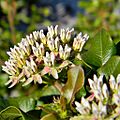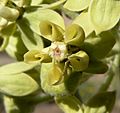Milkweed facts for kids
Quick facts for kids Milkweed |
|
|---|---|
 |
|
| Asclepias incarnata (swamp milkweed) flowers and a monarch butterfly | |
| Scientific classification |
|
| Kingdom: | Plantae |
| Clade: | Tracheophytes |
| Clade: | Angiosperms |
| Clade: | Eudicots |
| Clade: | Asterids |
| Order: | Gentianales |
| Family: | Apocynaceae |
| Subfamily: | Asclepiadoideae |
| Tribe: | Asclepiadeae |
| Subtribe: | Asclepiadinae |
| Genus: | Asclepias L. |
| Type species | |
| Asclepias syriaca L.
|
|
| Species | |
|
See List of Asclepias species |
|
Asclepias is a group of over 200 types of flowering plants, commonly known as milkweeds. These plants are named for the milky liquid, called latex, that oozes out when their stems or leaves are broken. This latex contains special chemicals that can be harmful to humans and many animals.
However, some animals, like the famous monarch butterfly, actually need milkweeds to survive! Monarch caterpillars eat only milkweed leaves. This helps them grow and even protects them from predators later on.
Milkweeds grow in many parts of the world, including Africa, North America, and South America. The name Asclepias was given to these plants in 1753 by Carl Linnaeus, a famous scientist. He named them after Asclepius, the ancient Greek god of healing.
Contents
Amazing Milkweed Flowers

Milkweed plants have some of the most interesting and complicated flowers you'll find! They are almost as complex as orchids. Each flower has five petals that bend backward. Inside, there's a special structure called a corona, which looks like a crown. This corona has five pairs of "hoods" and "horns" that help protect the flower's pollen. The shape and color of these hoods and horns are often used to tell different milkweed species apart.
How Milkweeds are Pollinated
Pollination in milkweeds is quite unique. Unlike most plants where pollen is in tiny grains, milkweed pollen is grouped into special packets called pollinia.
When an insect like a bee, wasp, or butterfly visits a milkweed flower, its legs or mouthparts can slip into small slits in the flower. The pollinia then stick to the insect. If the insect is strong enough, it pulls the pollen packets free when it flies away. The insect then carries these pollen packets to another milkweed flower, helping the plant reproduce. Sometimes, smaller insects can even get stuck and die if they can't pull free.
Large bees and wasps are usually the best pollinators for milkweeds. Interestingly, even though monarch butterflies depend on milkweeds, they are not very good at pollinating them!
Milkweed Seeds and Reproduction
After pollination, milkweed plants grow seed pods called follicles. Inside these pods, the seeds are neatly arranged in rows. Each seed has a cluster of white, silky hairs, often called "floss" or "silk."
When the pods ripen, they split open, and the wind carries the seeds and their silky parachutes far away. This is how milkweeds spread their seeds. Some milkweeds can also grow new plants from their roots, which is another way they reproduce.
Types of Milkweed Plants
There are over 200 different kinds of milkweeds! Here are some examples:
| Image | Scientific name | Common name | Where it grows |
|---|---|---|---|
 |
Asclepias albicans | Whitestem milkweed | Found in the Mojave and Sonoran deserts |
 |
Asclepias amplexicaulis | Blunt-leaved milkweed | Grows in central and eastern United States |
 |
Asclepias asperula | Antelope horns | Found in the American southwest and northern Mexico |
 |
Asclepias californica | California milkweed | Grows in central and southern California |
 |
Asclepias cordifolia | Heart-leaf milkweed | Found in the Sierra Nevada and Cascade Range |
 |
Asclepias cryptoceras | Pallid milkweed | Grows in the western United States |
 |
Asclepias curassavica | Scarlet milkweed, tropical milkweed | Originally from the American tropics, now found in other places |
 |
Asclepias curtissii | Curtiss's milkweed | Only found in sandy areas of Florida |
 |
Asclepias eriocarpa | Woollypod milkweed | Grows in California, Baja California, and Nevada |
 |
Asclepias erosa | Desert milkweed | Found in California, Arizona, and Baja California |
 |
Asclepias exaltata | Poke milkweed | Grows in eastern North America |
 |
Asclepias fascicularis | Narrow-leaf milkweed | Found in the Western United States |
 |
Asclepias hirtella | Tall green milkweed | |
 |
Asclepias humistrata | Sandhill milkweed | Grows in the southeastern United States |
 |
Asclepias incarnata | Swamp milkweed | Found in wet areas of North America |
 |
Asclepias lanceolata | Lanceolate milkweed | Grows along the coast of the eastern United States |
 |
Asclepias linaria | Pine needle milkweed | Found in Mojave and Sonoran deserts |
 |
Asclepias meadii | Mead's milkweed | Grows in the midwestern United States |
 |
Asclepias nyctaginifolia | Mojave milkweed | Found in the American southwest |
 |
Asclepias purpurascens | Purple milkweed | Grows in eastern, southern, and midwestern United States |
 |
Asclepias prostrata | Prostrate milkweed | Found in Texas and northern Mexico |
 |
Asclepias quadrifolia | Four-leaved milkweed | Grows in the eastern United States and Canada |
 |
Asclepias rubra | Red milkweed | |
 |
Asclepias solanoana | Serpentine milkweed | Grows in northern California |
 |
Asclepias speciosa | Showy milkweed | Found in the western United States and Canada |
 |
Asclepias subulata | Rush milkweed | Grows in southwestern North America |
 |
Asclepias subverticillata | Horsetail milkweed | |
 |
Asclepias sullivantii | Sullivant's milkweed | |
 |
Asclepias syriaca | Common milkweed | |
 |
Asclepias texana | Texas milkweed | |
 |
Asclepias tuberosa | Butterfly weed, pleurisy root | |
 |
Asclepias uncialis | Wheel milkweed | |
 |
Asclepias variegata | White milkweed | |
 |
Asclepias verticillata | Whorled milkweed | |
 |
Asclepias viridiflora | Green milkweed | |
 |
Asclepias viridis | Green antelopehorn, spider milkweed | |
 |
Asclepias welshii | Welsh's milkweed |
There are also 12 species of Asclepias in South America, including A. curassavica.
Milkweed and Nature's Balance
Milkweeds are very important for many insects. Their flowers provide nectar (a sugary liquid) for native bees, wasps, and other insects that drink nectar. However, sometimes non-native honey bees can get stuck in the flowers and die.
Milkweeds are also the main food source for monarch butterfly caterpillars. Many other insects, like certain beetles and moths, also eat milkweeds. These insects have special ways to deal with the plant's natural defenses.
How Milkweeds Protect Themselves
Milkweeds have three main ways to stop caterpillars from eating too much of them:
- Hairs on leaves: Some milkweed leaves have tiny hairs that make it hard for caterpillars to chew.
- Toxins: The milky liquid (latex) in milkweeds contains chemicals that can be harmful to insects.
- Latex fluid: When a leaf is bitten, the sticky latex can gum up an insect's mouthparts.
Scientists have found that newer types of milkweeds might not use these defenses as much. Instead, they grow very quickly, perhaps faster than caterpillars can eat them!
Milkweeds and Monarch Butterflies

The leaves of milkweed plants are essential for monarch butterfly caterpillars. Because of this, people often plant milkweeds in their gardens to help the shrinking monarch population. These gardens are sometimes called "monarch waystations."
However, it's important to plant the right kind of milkweed. For example, tropical milkweed is often planted in gardens outside of its natural home in Mexico and Central America. If this type of milkweed grows all year round in places like the U.S. Gulf Coast, it can cause problems for monarchs. It might stop them from migrating properly and can lead to a harmful parasite called Ophryocystis elektroscirrha (OE) spreading more easily. This parasite can make holes in monarch butterfly wings, making it hard for them to fly long distances.
To help monarchs, it's best to plant milkweed species that naturally grow in your local area. Some milkweeds, like butterfly weed, have very few of the protective chemicals, so monarch caterpillars might not like them as much.
Uses of Milkweed
Milkweeds are not usually grown on big farms, but people have used them in many ways throughout history.
Traditional and Medicinal Uses
Native American groups, like the Omaha people and Menomin, traditionally used common milkweed (A. syriaca) for healing purposes.
Fibers and Floss
The strong fibers from some milkweed stems can be used to make rope. The Miwok people in California used the stems of heart-leaf milkweed (A. cordifolia) to make cords and ropes.
The soft, silky fluff attached to milkweed seeds is called floss. It's very light and smooth, which makes it hard to spin into yarn by itself. But if you mix it with wool or other fibers, it can be used to make yarn.
During World War II, a lot of milkweed floss was collected in the U.S. to use as a filling for life jackets. This was because another material, kapok, was hard to get. Milkweed floss is hollow and waxy, which makes it good for insulation. Today, milkweed is sometimes used as a filling for pillows and winter coats because it's hypoallergenic (less likely to cause allergies). It could be a plant-based alternative to down feathers.
Milkweed floss is also very good at floating and repelling water, but it soaks up oil easily. This means it can be used to help clean up oil spills!
Other Uses
The milky liquid (latex) from milkweeds contains a small amount of natural rubber. During World War II, both Germany and the U.S. tried to use it as a source of rubber, but it wasn't very successful on a large scale.
Some milkweed species have chemicals that can be poisonous. Because of this, some groups of people in South America and Africa used arrows tipped with these chemicals for hunting. While some milkweeds can be harmful if eaten in large amounts, some types can be made safe to eat if prepared correctly.
See also
 In Spanish: Asclepias para niños
In Spanish: Asclepias para niños



